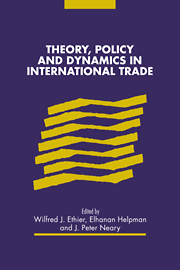Book contents
1 - Scope of the volume
Published online by Cambridge University Press: 16 March 2010
Summary
This volume has two interrelated purposes: to present a selection of important contemporary work in international trade theory at the beginning of the 1990s, and to honor Ronald Jones, one of the leading post-war figures in international economics. Although Jones is still as active and innovative a researcher as ever, his sixtieth birthday in 1991 provided an opportunity to assess and honor his contributions. With this in mind, a conference was organized at the University of Pennsylvania in November 1990, at which drafts of the papers in this volume were presented. The result, we hope, is a collection of papers which shows both the continuing influence of Jones's work and the increasing diversity and maturity of international trade theory.
Chapter 2, by Wilfred Ethier, attempts to assess Ronald Jones's contributions to international trade theory, while the remainder of the book contains representative work from the frontier of the field. The remainder of the present chapter introduces the subsequent contributions and attempts to place them in context. We have arranged them so that they form a natural progression, starting in Part II with the spatial and historical context of international trade and moving through positive and normative issues in static models of trade (in Parts III and IV respectively) to work on dynamics and growth in Part V.
In chapter 3 Paul Krugman continues his recent work on geography and trade. Whereas previously he developed a theory of industrial specialization based on agglomeration effects in production and a regional dispersion of demand, here he builds a theory of industrial specialization based on agglomeration and transportation “hubs.” The main idea is that transport costs differ across pairs of countries and regions.
- Type
- Chapter
- Information
- Publisher: Cambridge University PressPrint publication year: 1993



